Reactions To Tragedy
Reactions to tragedy
In real life, pretty much everybody reacts to tragedy differently. So why is it that every author has their pet reaction to tragedy that all their characters use? Not only is it unrealistic, but it takes away the chance for the characters’ different reactions to reveal things about themselves.
Possible reactions to tragedy (not an exhaustive list):
Distracting oneself with mindless activities
Distracting oneself with others’ humor
Distracting oneself by making jokes
Distracting oneself by reading/watching/playing stories
Distracting oneself with hard mental work
Distracting oneself with hard physical work
Distracting oneself with creative endeavors
Distracting oneself by chatting with friends about normal things
Talking to friends about the tragedy
Talking to authority figures about the tragedy
Talking anonymously with strangers about the tragedy (if possible)
Getting wrapped up in others’ problems
Staying unusually silent
Screaming
Crying loudly
Crying silently
Doing everything possible not to cry
Pacing
Taking unhealthy risks
Going for revenge against whoever one can blame
Punching random objects
Throwing random objects
Lashing out against friends and family members
Trying to prevent a similar tragedy from happening
Eating more than usual
Not eating
Taking mind-altering substances
Getting in unhealthy relationships
Isolating oneself
Obsessing over routine
Numbness combined with apathy
Numbness combined with going through one’s normal motions
Trying to get things back the way they were
Denial
No reaction at first but a reaction hits later in greater force
No reaction at all. Emotions relating to the tragedy just fail to load. Note that this can happen to anybody and does not mark a character as a sociopath.
Characters can have more than one reaction at the same time, one reaction after another, or different reactions to different tragedies.
More Posts from Writersreferencez and Others





I made these as a way to compile all the geographical vocabulary that I thought was useful and interesting for writers. Some descriptors share categories, and some are simplified, but for the most part everything is in its proper place. Not all the words are as useable as others, and some might take tricky wording to pull off, but I hope these prove useful to all you writers out there!
(save the images to zoom in on the pics)
One of the best tips for writing descriptions of pain is actually a snippet I remember from a story where a character is given a host of colored pencils and asked to draw an egg.
The character says that there’s no white pencil. But you don’t need a white pencil to draw a white egg. We already know the egg is white. What we need to draw is the luminance of the yellow lamp and the reflection of the blue cloth and the shadows and the shading.
We know a broken bone hurts. We know a knife wound hurts. We know grief hurts. Show us what else it does.
You don’t need to describe the character in pain. You need to describe how the pain affects the character - how they’re unable to move, how they’re sweating, how they’re cold, how their muscles ache and their fingers tremble and their eyes prickle.
Draw around the egg. Write around the pain. And we will all be able to see the finished product.
A list of phobias that your OC (original character) can have
Arachnophobia: Fear of spiders.
Acrophobia: Fear of heights.
Claustrophobia: Fear of confined or crowded spaces.
Ophidiophobia: Fear of snakes.
Cynophobia: Fear of dogs.
Trypophobia: Fear of clusters of small holes or bumps.
Social Anxiety Disorder (SAD): Fear of social situations and interactions.
Glossophobia: Fear of public speaking.
Hemophobia: Fear of blood.
Nyctophobia: Fear of darkness or night.
Thanatophobia: Fear of death or dying.
Mysophobia: Fear of germs or dirt.
Entomophobia: Fear of insects.
Aquaphobia: Fear of water.
Astraphobia: Fear of thunder and lightning.
Dentophobia: Fear of dentists or dental procedures.
Selenophobia: Fear of the moon.
Taphophobia: Fear of being buried alive or of cemeteries.
Xenophobia: Fear of strangers or foreigners.
Atychiphobia: Fear of failure or not being good enough.
Consider which phobia fits well with your OC's personality, background, and the story you want to tell. You can also explore how their phobia influences their behavior, relationships, and journey throughout the novel.
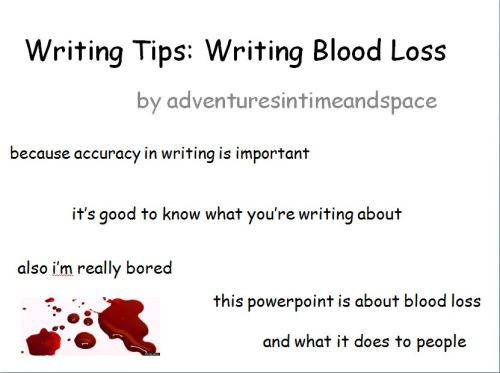
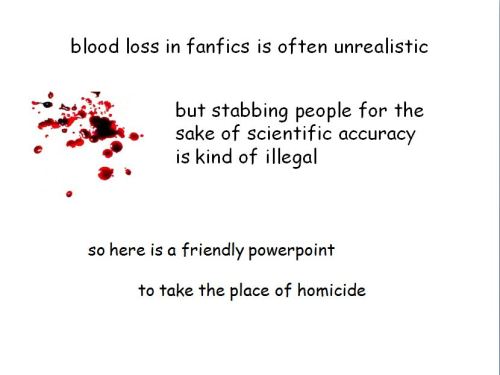

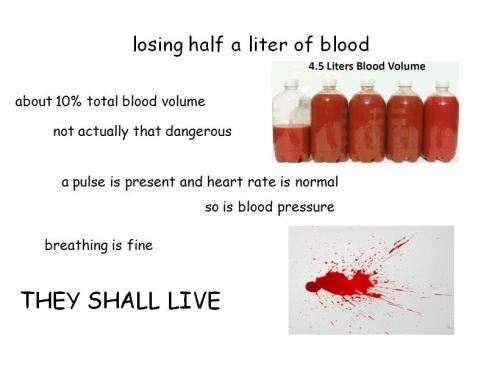
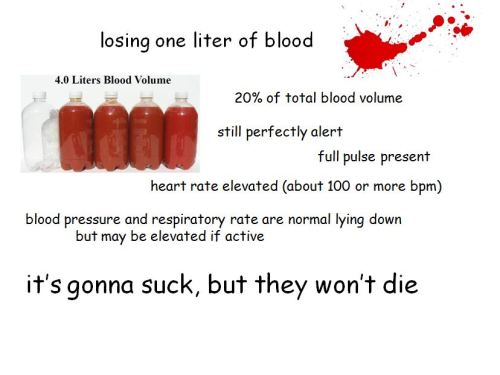
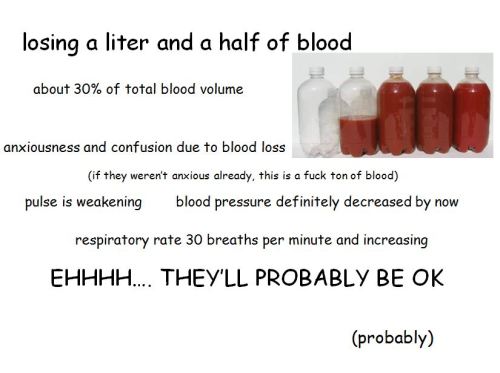



Here are some scientific facts about blood loss for all you psychopaths writers out there.
Showing 'Anger' in Writing
Clenched fists and knuckles turning white.
Eyes narrowing to slits, brows furrowed.
Jaw muscles tensing visibly.
Speaking through gritted teeth.
Taking deep, sharp breaths.
Pacing back and forth, unable to stay still.
Pointing a finger accusingly.
Voice raising to a shout or a growl.
Kicking or punching nearby objects.
Lips pressed together in a thin line.
Rapid, agitated movements.
Slamming doors or throwing objects.
Standing with arms crossed tightly.
Glaring intensely without blinking.
Face turning red or flushed.
Breathing heavily and erratically.
Snapping at others for minor things.
Shaking with barely contained rage.
Muttering or growling under their breath.
Eyes blazing with fury.

Using the “rule of 3” works when it comes to showing your character’s emotional response. Source
Writing Tips
Punctuating Dialogue
✧
➸ “This is a sentence.”
➸ “This is a sentence with a dialogue tag at the end,” she said.
➸ “This,” he said, “is a sentence split by a dialogue tag.”
➸ “This is a sentence,” she said. “This is a new sentence. New sentences are capitalized.”
➸ “This is a sentence followed by an action.” He stood. “They are separate sentences because he did not speak by standing.”
➸ She said, “Use a comma to introduce dialogue. The quote is capitalized when the dialogue tag is at the beginning.”
➸ “Use a comma when a dialogue tag follows a quote,” he said.
“Unless there is a question mark?” she asked.
“Or an exclamation point!” he answered. “The dialogue tag still remains uncapitalized because it’s not truly the end of the sentence.”
➸ “Periods and commas should be inside closing quotations.”
➸ “Hey!” she shouted, “Sometimes exclamation points are inside quotations.”
However, if it’s not dialogue exclamation points can also be “outside”!
➸ “Does this apply to question marks too?” he asked.
If it’s not dialogue, can question marks be “outside”? (Yes, they can.)
➸ “This applies to dashes too. Inside quotations dashes typically express—“
“Interruption” — but there are situations dashes may be outside.
➸ “You’ll notice that exclamation marks, question marks, and dashes do not have a comma after them. Ellipses don’t have a comma after them either…” she said.
➸ “My teacher said, ‘Use single quotation marks when quoting within dialogue.’”
➸ “Use paragraph breaks to indicate a new speaker,” he said.
“The readers will know it’s someone else speaking.”
➸ “If it’s the same speaker but different paragraph, keep the closing quotation off.
“This shows it’s the same character continuing to speak.”
Writing Trust Issues Tension
One keeps asking, “Are you sure?” and “What about…?” because they just can’t believe the other person.
Every little thing the other person says or does is met with suspicion, like, “Why are you really doing this?”
They start to open up, then stop, because they’re not sure if they can trust the other person yet.
One keeps asking for reassurance, like, “You wouldn’t lie to me, right?” but it’s clear they’re not convinced.
A tiny mistake or secret gets blown way out of proportion because the trust was already shaky.
diferent ways to describe the fear of something?
Different Ways to Describe Fear
Symptoms of Fear:
accelerated breathing
accelerated heart rate
goosebumps
sweating
sleep disturbance
butterflies in stomach
dizziness
Body Language Responses to Fear:
hunching shoulders
shrinking away
wide eyes
shaking / trembling
freezing
wrapping arms around themselves
shaking hands
Writing Prompts:
-> feel free to edit and adjust pronouns as you see fit.
She pressed a trembling hand to her chest as if that would do anything to slow her racing heart.
His eyes were crazed, darting around to look at the shadows of the room.
Their limbs felt like jelly, afraid that they would collapse at any moment.
She was utterly frozen. Her body cut all communication with her mind, and no matter how much her brain screamed for her to run she was immobilized in terror.
He had a tight knot forming in his stomach.
They couldn't breathe. They were totally suffocated by fear and it felt like a heavy weight was pressing down on their chest.
Dread clouded her thinking. She walked around like she was in a daze, relying solely on muscle memory to get her down the hallway.
His hands were trembling so badly that he couldn't do anything and his terror made it impossible to focus.
Their throat was dry. No matter how many times they swallowed it did nothing to relieve the uncomfortable feeling.
The salty taste of fear lingered on her lips.
His muscles screamed at him to leave, but he couldn't bring himself to move. He stared forwards hauntingly.
They ran. They ran faster than their legs had ever carried them, adrenaline taking over all of their senses. It felt like they were being chased, but there was no way for them to know for certain. They were too afraid to turn around.
It felt like her heart was about to burst from her ribcage.
10 Non-Lethal Injuries to Add Pain to Your Writing
While lethal injuries often take center stage, non-lethal injuries can create lasting effects on characters, shaping their journeys in unique ways. If you need a simple way to make your characters feel pain during a scene, here are some ideas:
Sprained Ankle
A common injury that can severely limit mobility, forcing characters to adapt their plans and experience frustration as they navigate their environment.
Rib Contusion
A painful bruise on the ribs can make breathing difficult and create tension, especially during action scenes, where every breath becomes a reminder of vulnerability.
Concussion
This brain injury can lead to confusion, dizziness, and mood swings, affecting a character’s judgment and creating a sense of unpredictability in their actions.
Fractured Finger
A broken finger can complicate tasks that require fine motor skills, causing frustration and emphasizing a character’s dependence on their hands.
Road Rash
The raw, painful skin resulting from a fall can symbolize struggle and endurance, highlighting a character's resilience in the face of physical hardship.
Shoulder Dislocation
This injury can be excruciating and often leads to an inability to use one arm, forcing characters to confront their limitations while adding urgency to their situation.
Deep Laceration
A cut that requires stitches can evoke visceral imagery and tension, especially if the character has to navigate their surroundings while in pain.
Burns
Whether from fire, chemicals, or hot surfaces, burns can cause intense suffering and lingering trauma, serving as a physical reminder of a character’s past mistakes or battles.
Pulled Muscle
This can create ongoing pain and restrict movement, providing an opportunity for characters to experience frustration or the need to lean on others for support.
Tendonitis
Inflammation of a tendon can cause chronic pain and limit a character's ability to perform tasks they usually take for granted, highlighting their struggle to adapt and overcome.
Looking For More Writing Tips And Tricks?
Check out the rest of Quillology with Haya; a blog dedicated to writing and publishing tips for authors! Instagram Tiktok
-
 chancellorcannoli reblogged this · 1 month ago
chancellorcannoli reblogged this · 1 month ago -
 newdawnhorizon reblogged this · 1 month ago
newdawnhorizon reblogged this · 1 month ago -
 spideronthesun liked this · 1 month ago
spideronthesun liked this · 1 month ago -
 tenacioustooru liked this · 2 months ago
tenacioustooru liked this · 2 months ago -
 loyalguma liked this · 3 months ago
loyalguma liked this · 3 months ago -
 beyondhumanbelief liked this · 6 months ago
beyondhumanbelief liked this · 6 months ago -
 suzerainoflegend reblogged this · 7 months ago
suzerainoflegend reblogged this · 7 months ago -
 suzerainoflegend liked this · 7 months ago
suzerainoflegend liked this · 7 months ago -
 inventedonearth liked this · 7 months ago
inventedonearth liked this · 7 months ago -
 lucky-cataclysme liked this · 8 months ago
lucky-cataclysme liked this · 8 months ago -
 star-of-the-sea-ta liked this · 8 months ago
star-of-the-sea-ta liked this · 8 months ago -
 harkentothewhispers liked this · 9 months ago
harkentothewhispers liked this · 9 months ago -
 autistic-at-the-disco liked this · 9 months ago
autistic-at-the-disco liked this · 9 months ago -
 bayduh liked this · 10 months ago
bayduh liked this · 10 months ago -
 diaphanouz reblogged this · 1 year ago
diaphanouz reblogged this · 1 year ago -
 acoolmochiuwu liked this · 1 year ago
acoolmochiuwu liked this · 1 year ago -
 limik0 liked this · 1 year ago
limik0 liked this · 1 year ago -
 beautifulashes17 liked this · 1 year ago
beautifulashes17 liked this · 1 year ago -
 prompts-for-every-need liked this · 1 year ago
prompts-for-every-need liked this · 1 year ago -
 hydrangeahelper reblogged this · 1 year ago
hydrangeahelper reblogged this · 1 year ago -
 apeshit liked this · 1 year ago
apeshit liked this · 1 year ago -
 tbhcreacher reblogged this · 1 year ago
tbhcreacher reblogged this · 1 year ago -
 tbhcreacher liked this · 1 year ago
tbhcreacher liked this · 1 year ago -
 franesovol liked this · 1 year ago
franesovol liked this · 1 year ago -
 tilipohy liked this · 1 year ago
tilipohy liked this · 1 year ago -
 empireroyals liked this · 1 year ago
empireroyals liked this · 1 year ago -
 written-in-sunshine reblogged this · 1 year ago
written-in-sunshine reblogged this · 1 year ago -
 greymousedragon liked this · 1 year ago
greymousedragon liked this · 1 year ago -
 petaltailify liked this · 1 year ago
petaltailify liked this · 1 year ago -
 sengawolf reblogged this · 1 year ago
sengawolf reblogged this · 1 year ago -
 westernbiblestory reblogged this · 1 year ago
westernbiblestory reblogged this · 1 year ago -
 star-boy-come-back reblogged this · 2 years ago
star-boy-come-back reblogged this · 2 years ago -
 star-boy-come-back liked this · 2 years ago
star-boy-come-back liked this · 2 years ago -
 toitown liked this · 2 years ago
toitown liked this · 2 years ago -
 starsharks liked this · 2 years ago
starsharks liked this · 2 years ago